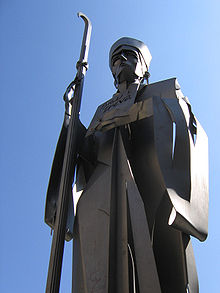Oliba de Besalu

Abbot Oliba ( Catalan Abat Oliba ) (* 971 in Besalú , † 1046 in Saint-Michel-de-Cuxa ) was Count of Berga , abbot of various Benedictine monasteries and bishop of Vic . He is seen by many as the “spiritual father” of Catalonia .
biography
Oliba was the third son of Count Oliba Cabreta of Cerdanya and Besalú and his wife Ermengarda, and thus a direct descendant of Wilfried the Hairy , the founder of the dynasty of the Counts of Barcelona .
From 998 to 1003 he was Count von Berga, then gave up his title and entered the Ripoll monastery founded by Wilfried . In 1008 he was elected its abbot; a year later also abbot of Saint-Martin-du-Canigou . In 1011 he made a trip to Rome , during which he succeeded in obtaining the privilege in a bull from Pope Sergius IV that the Catalan monasteries were directly subordinate to the papal see, which gave them a high degree of independence from secular influence obtained. In 1018 he was also made Bishop of Vic . In the following years he founded other monasteries - e.g. B. Santa Maria de Montserrat , Sant Miquel de Fluvià and Saint-Martin du Canigou .
Oliba died in 1046 in the monastery of Saint-Michel-de-Cuxa , which is now in the French Pyrenees ( Roussillon ), but was then part of the county of Barcelona . His name is carved on the altar plate there.
effect
While traveling to Rome he came into contact with Popes Sergius IV and Benedict VIII. During these trips he was impressed by the architectural style of the Roman and, above all, the Lombard churches, so that he used them as models for many new buildings in his own sphere of influence thus introduced a new architectural style in Catalonia. Between 1025 and 1035 he founded or renewed the monasteries of Montserrat and Saint-Martin-du-Canigou; He is also considered to be the builder of the Basilica of Santa Maria in Ripoll , consecrated in 1032 and considered to be one of the most beautiful buildings of the Spanish Romanesque . The new construction of Vic Cathedral, which was completed or consecrated in 1038, is also very likely due to his initiative.
In addition, he was one of the initiators of the socially important Treuga dei movement ( Catalan : Pau i Treva de Déu ) in Catalonia and was involved in the reconstruction of the cities of Manresa and Cardona, which were destroyed by Moorish troops .
He was also a great promoter of the art of writing. The scriptorium of the monastery in Ripoll is famous for its extensive library. Here - next to Toledo - was one of the centers for the translation of old Arabic manuscripts into Latin. Thanks to his initiative, cultural life in Catalonia flourished again.
His initiatives had a long lasting effect - there is still a Fundación Abat Oliba in Catalonia to this day . The Abbot Oliba University in Barcelona is named after him.
literature
- Eduard Junyent i Sobirà, M. Mundó Anscari (ed.): Diplomatari i escrits literaris de l'abat i bisbe Oliba (en llatí i català) . Institut d'Estudis Catalans, 2002, ISBN 84-7283-204-X .
Web links
- Ways of Abbot Oliba. Travel in Catalonia in the year 1000 - Departament d'Empresa i Coneixement
| personal data | |
|---|---|
| SURNAME | Oliba de Besalu |
| ALTERNATIVE NAMES | Abbot Oliba |
| BRIEF DESCRIPTION | Count of Berga, abbot of various Benedictine monasteries and bishop of Vic |
| DATE OF BIRTH | 971 |
| PLACE OF BIRTH | Besalú , County of Besalú |
| DATE OF DEATH | 1046 |
| Place of death | Saint-Michel-de-Cuxa , Barcelona county |